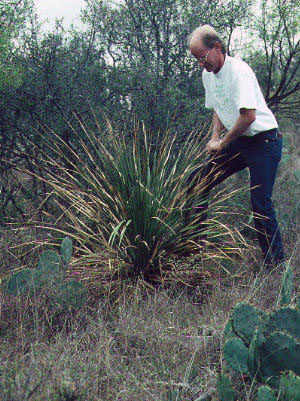This exhibit was written by J. Philip (Phil) Dering, who also took most of the photographs. TBH editor Steve Black contributed minor writing. The initial ethnobotany exhibit appeared in 2006 and was revised with new additions in 2008. TBH editorial assistant Heather Smith designed the exhibit and did the web programming. The Amistad National Recreation Area of the National Park Service (ANRA-NPS) sponsored the ethnobotany exhibit. Author Phil Dering is an archeologist and paleoethnobotanist, who studies plant remains from archeological sites. Born in Fort Worth and raised in Corpus Christi, his lifelong interest in natural history was fostered by the islands, bays, and rivers of the Texas coast. He received a B. A. in Anthropology, with many hours in biology, from Texas A&M University in 1975 and immediately began work on an M. S. in Botany at the same institution. He established a plant collection suited specifically for analysis of dry cave deposits, and analyzed the plant remains from Hinds Cave and other archeological sites in southwestern Texas. His Ph.D. dissertation research at Texas A&M was a study of prehistoric agriculture, based on the analysis of plant remains from 52 Classic period archeological sites in Tonto Basin, Arizona. Dering's research interests center on relationships between plants and people, particularly Archaic period hunters and gatherers of the Southern Plains, the Gulf Coast, and the Chihuahuan Desert. He has always been interested in how people lived directly off the land—techniques that many consider "survival skills" but he thinks of them as "living skills." This curiosity has led to a long-term study of plant foods. He is particularly interested in how people baked foods in earth ovens. Since 1993 he has constructed over 60 earth ovens, using them to cook lechuguilla, sotol, yucca, false garlic, and onions. Although he analyzes plant remains from every corner of Texas, his favorite archeological area is the Lower Pecos Canyonlands. Today (2008) Phil lives in the area and closely watches its plants wax and wane with the seasons and prevailing climate. He teaches science at Comstock High School. He continues to carry out experimental archeological and ethnobotanical research aimed at understanding how native peoples used plants. Unless otherwise attributed, all of the photographs in the Ethnobotany Gallery were taken by Dering. |
|
Links:Plateaus and Canyonlands, Nature's Harvest, Plant Gallery [elsewhere on TBH, also by Dering] South Texas Plains, Nature's Harvest, Plant Gallery [elsewhere on TBH , also by Dering] Trans-Pecos Mountains and Basins, Nature's Harvest, Plant Gallery [elsewhere on TBH, also by Dering] Coastal Prairies and Marshes, Nature's Harvest, Plant Gallery [elsewhere on TBH, also by Dering] Ethnobotany entry, Wickipedia. Plants Database, Natural Resources Conservation Service, USDA [Very useful source for plant profile information, images, and links.] Ethnobotany Research and Applications- A Journal of Plants, People and Applied Research [free access to online research journal] Useful Wild Plants [Non-profit organization that seeks to publish a 12-volume encyclopedia of over 4,000 Texas plants. The two volumes published so far are great sources of detailed information.] Printed Sources:Cited sources appear at the bottom of each plant entry. Here are a few general sources on ethnobotany. Paye, Gabriell D. Schultes, Richard Evans and Siri Von Reis |
